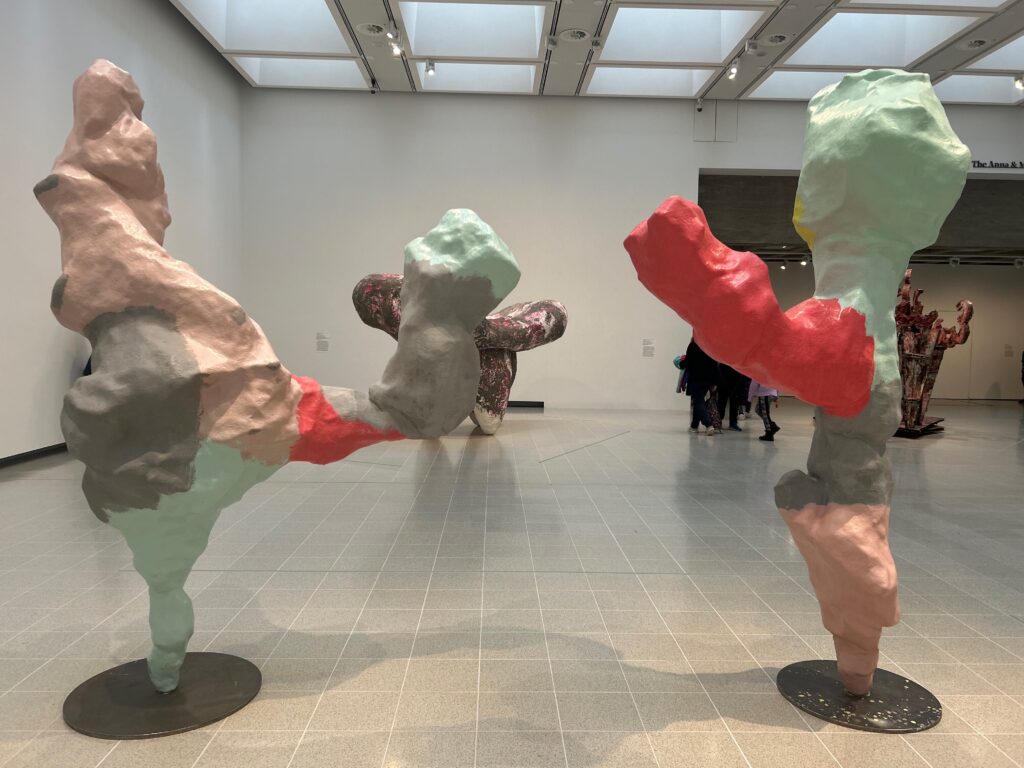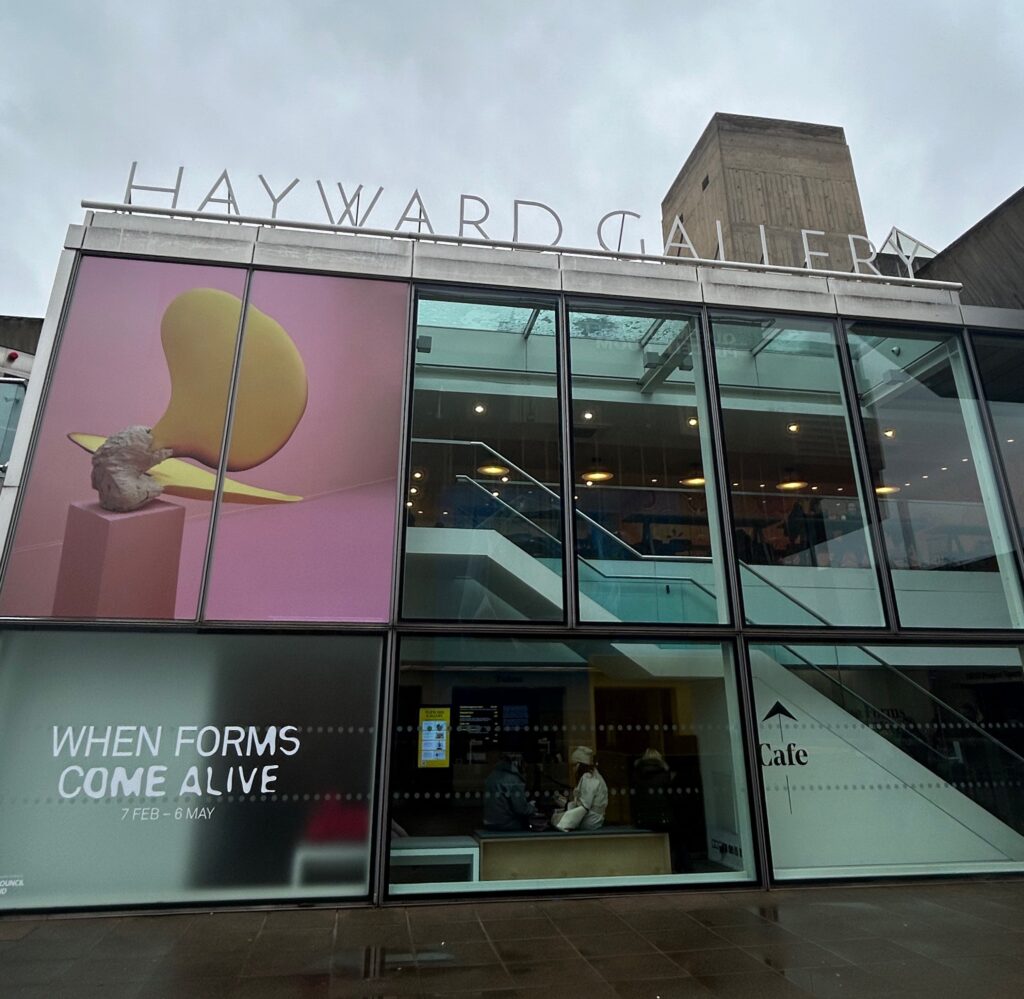When Forms Come Alive: Sixty Years of Restless Sculpture brings together sculpture by 21 artists inspired by irregular and unexpected forms found in nature. This playful exhibition curated by Ralph Rugoff, with Assistant Curator Katie Guggenheim and Curatorial Assistant Anusha Mistry, emphasises the influence of flux, movement and organic growth on contemporary sculpture.
Spanning over 60 years of contemporary art, this unique survey exhibition includes a range of energetic sculptural forms that seem to ooze, undulate, blossom, erupt and sprawl in the gallery space, inspiring fluid and shifting realms of experience, surprising viewers at every turn. When Forms Come Alive brings together works that engage in a dynamic and urgent exploration of physical experience in contrast to a world in which everyday encounters are increasingly digitised.

The exhibition features the works of 21 international artists; Ruth Asawa, Nairy Baghramian, Phyllida Barlow, Lynda Benglis, Michel Blazy, Paloma Bosquê, Olaf Brzeski, Choi Jeonghwa, Tara Donovan, DRIFT, Eva Fàbregas, Holly Hendry, EJ Hill, Marguerite Humeau, Jean-Luc Moulène, Senga Nengudi, Ernesto Neto, Martin Puryear, Matthew Ronay, Teresa Solar Abboud and Franz West.
When Forms Come Alive lives up to its name and brings the brutalist gray concrete exhibition rooms of the Hayward Gallery to life with pulsating, undulating forms, and living sculptures including Michel Blazy’s foam sculpture created from a scaffolding tower of window boxes oozing bubbles, and DRIFT’s performative sculpture ‘Skylight’, comprising a group of robotic forms suspended from the ceiling that interact playfully with visitors.
Michel Blazy regards his artworks as experiments and considers his ephemeral sculptures to be living beings. Fascinated by ‘the wild aspect of things’, he began experimenting with foam in order to give ‘it back its freedom’. Bouquet final’s wall of foam constantly grows, mutates and eventually disintegrates almost imperceptibly.
DRIFT describe Shylight as ‘a performative sculpture; when you enter the space it becomes a kind of dance that is performed in front of you.’ Shylight’s fluidly ascending and descending lights are programmed to open and close like flowers whose petals furl and unfurl in response to changes in light or climate.
DRIFT’s aim is to call attention to such rhythms and harmonies in our everyday natural environment. The impetus for their work can be as varied as the flight patterns of birds, a proliferation of dandelion seedheads, or the formation of a mass of clouds, coupled with innovative, cutting-edge technology.
‘Skylight’ from Amsterdam collective DRIFT, is reminiscent of Anicka Yi’s 2021 flying jellyfish installation for Tate Modern’s Turbine Hall and has a similar effect on visitors to the Hayward Gallery, showing how sculpture can transform a space, and how robots have a human aspect that invites interaction with people.

Culturalee visited during half term when lots of little people were completely captivated by the unexpected forms, shapes and bright colours of the sculptures on display. Apart from the jellyfish and foam on the ground floor, other highlights include Franz West’s ‘Epiphanie an Stuhlen’ (‘Epiphany on Chairs), a huge DNA sphere in the palette of pink blancmange suspended from the high-ceilinged, light-filled gallery on the upper floor, and his ‘Kain naht Abel’ sculpture – a pair of sparring sculptural forms inspired by the Biblical characters Cain and Abel. Complementing the Franz West sculptures in palette and scale are vast mottled pink sculptures by the late Phyllida Barlow.
Traditional sculpture is often solid and permanent, while the sculpture on display at the Hayward Gallery breaks away from the rigidity of tradition and embraces more organic, playful forms. Children will love EJ Hill’s neon LED roller coaster sculpture and Teresa Solar Abboud’s ‘Tunnel Boring Machine’ sculptures which resemble crab claws and organic forms.

EJ Hill
A new commission titled ‘Sottobosco’ by Holly Hendry, resembles an undulating green caterpillar and emulates the city skyline visible through the window behind it. Hendry created the sculpture with steel ducting, blown glass, jesmonite and paint, using industrial materials to emulate ‘Sottobosco’, an Italian word for the dense undergrowth of the forest.
Ralph Rugoff, Director of the Hayward Gallery, says: “Dynamic, exuberant and playful, the works in this show take visitors on an adventure into a world of fascinating forms. Whilst they avoid directly representing the human body, most of these artworks evince a compelling corporeality – they remind us that there is a comedy, as well as a politics, of form.”

Holly Hendry
Embodying a playful rebuke to rigid geometries, the sculptures in When Forms Come Alive evoke the pleasures of spontaneous gesture and movement, the poetics of gravity, and the experience of sensation itself. In addition, the works engage viewers in ambiguous encounters with uncanny forms that cannot be easily identified or labelled. For example, Jean-Luc Moulène’s knot-like constructions explore paradoxical volumes defined by surfaces that have neither inside nor outside, whilst Teresa Solar Abboud’s brightly coloured sculptures, at once naturalistic and surreal, embody an intractable, dynamic otherness. Alongside Tara Donovan’s intricate installation that brings to mind a sprawling, otherworldly molecular constellation, these artworks defiantly proclaim that nothing in the world stays the same, that everything is moving, seething, changing and transforming. These works, and the exhibition as a whole, illuminates how sculpture, by embracing its potential as our most restless medium, can be an indispensable vehicle for rediscovering and recovering lost dimensions of physical experience.
The exhibition opens with sculptures from the 1960s and 1970s by postminimalist and process-oriented artists, including Lynda Benglis and Senga Nengudi, showcasing how form is inseparable from a sense of transience and transformation – an aesthetic developed in pointed contrast to the sleek monolithic structures created by many male artists of the time. Later works from artists such as Phyllida Barlow and Nairy Baghramian pick up on this anti-monumental character, presenting deliberately awkward forms that evoke fleeting states of being, or relationships in flux.
Works from artists Franz West, Olaf Brzeski and Matthew Ronay utilise forms to conjure the abject, comedic and absurd. The unexpected bulges and curves in these sculptures might evoke associations to living organisms from one viewpoint, but when seen from another angle, they suggest geological formations or melting ice cream. Meanwhile, with its neon, rollercoaster-like structure, EJ Hill’s large-scale sculpture triggers memories of radical motion and visceral highs, to which the artist links the politics of Black joy and the historical exclusion of African-Americans from amusement parks in areas of the USA.

Organic life is a key departure point for many of the artists in the show. Inspired by her observations of natural forms, Ruth Asawa’s wire sculptures made in the 1950s and 1960s nest spherical forms inside hourglass shapes, suspended from the gallery ceiling to enable their subtle motion. Made from silk, DRIFT’s kinetic Skylights mimic the folding and unfolding of flowers that close at night, whilst Marguerite Humeau’s multimedia sculptures echo the gills of mushrooms and honeycomb-like structures to conjure scenarios of organic metamorphosis and adaptation.
The exhibition is accompanied by a richly illustrated, hardback catalogue that explores the artists and their work in detail. The book includes essays by Hayward Gallery Director Ralph Rugoff and art historian Natalie Rudd which expand on the key themes of the show, citing the artists’ work within the context of postminimalism, and exploring formal and material innovation in sculpture across the past half century. Texts on each artist by a range of writers accompanies a broad-ranging selection of images.
The sensuous textures and surprising physical qualities of the works in this exhibition invite us to look with a tactile gaze, as if our eyes could touch and feel directly. In an era when our encounters are increasingly digitised and disembodied, these artists return us to an active exploration of the tangible forms around us. Often seeing their work as a collaboration with different materials and processes, they remind us that everything in the world is always moving, seething, transforming.
When Forms Come Alive: Sixty Years of Restless Sculpture is at the Hayward Gallery until 6th May, 2024.
https://www.southbankcentre.co.uk/venues/hayward-gallery




